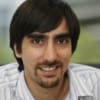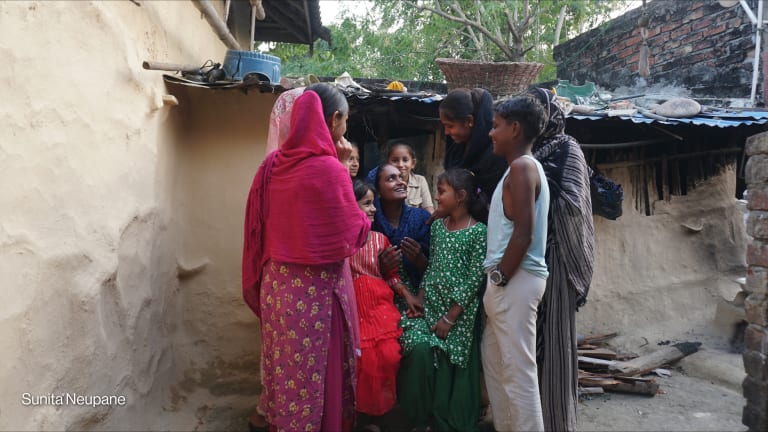
Our van kicks up clouds of brown dust as we drive down the uneven dirt road toward Community Health Clinic #3 on Bussi island. Our guide Lucy Shillingi of Pathfinder International points out a passing truck heaped with bundles of chopped wood.
“Deforestation is a real issue here,” she says, explaining that the island is being depleted with each truckload that is sent to the boats for shipping. “This is why we teach the people about sustainability.”
The health clinic is a modest rectangular structure. At the front of the clinic are small groups of women talking with volunteer community health workers about family planning. The clinic does not have enough trained professionals so staff of Health of People & Environment, or HoPE, trained local members of the community via 10-day intensive training sessions on how to provide counseling and other needed services.
One of these trained community members is showing a woman in the group how to use “moon beads,” a simple invention that helps women track their menstrual cycle in order to make use of the “calendar” or rhythm method of contraception. The clinic teaches women the importance of “spacing” — a term used to avoid the negative connotations of birth “control” — and offers a variety of options including cycle beads, condoms, pills, intrauterine devices and implants. Family planning methods, such as delaying and spacing out children, are among the most effective ways to better the lives of families and directly contribute to the U.N. Millennium Development Goals of reducing infant mortality and improving maternal health (goal #4 and #5, respectively). Apart from women’s services, the clinic also provides vaccinations, HIV counseling, tuberculosis and malaria treatment, and other forms of sick care.
The midwife at the clinic is particularly excited about a new “solar suitcase” they received from WE Care Solar. The suitcase provides a rooftop solar panel connected to a wall‑mounted unit that includes two battery-operated fetal dopplers, a battery and phone charging station, and an LED task light that’s connected to the unit with a long cord. Before the arrival of the suitcase, it was almost impossible to offer birthing services at night (when most births actually occur) simply due to lack of light. The task light connected to the solar suitcase can fully light a room and had an immediate impact on evening services. Within a short time, nighttime births in the clinic — which are much safer than births that happen elsewhere — have skyrocketed from three to 50 per month.
One curious feature of this clinic is that during all the treatment and counseling that we witness, the health workers are also having conversations with people about the environment and sustainable farming and fishing. And at the end of our visit, just before leaving, staff members make us plant a tree on the clinic grounds. I’m puzzled by what feels like an out-of-place act for a medical facility. Lucy explains that they use the opportunity of people coming into the clinic to educate them on sustainable living.
It isn’t until our next stop, a visit to a “model home,” that I come to understand how deeply health and ecological sustainability are connected.
Annet’s story
We visited a home owned and operated by a woman named Annet. On Annet’s 2-acre plot sat a modest brick home similar to others on the island, but unique in that its corrugated steel roof had gutters with pipes that led to a large spherical concrete rain catcher. Around the home was lush vegetation, a combination of tall trees beneath which grew hundreds of aubergine plants and dozens of banana trees. Through a translator, Annet began to explain that her land had been completely barren until she was taught how to cultivate it.
One could not help but notice her incredible poise and sense of confidence as she proudly described each feature of her property. Annet showed us the specific vegetation she had planted to add nitrogen to the soil. We walked through gullies she had dug to prevent erosion during the rainy season. And between the plants we saw the dead leaves and twigs Annet was using as mulch to retain moisture.
When we stopped at a banana tree Annet stood proudly beneath it and said, “Look at this tree and how much fruit it has on it. This is because of spacing.”
Spacing? I had just been told that spacing was all about spreading out children — what could it possibly have to do with bananas? Annet explained that banana trees spawn additional trees beside them, like children. A tree will yield much more fruit if those smaller “baby” trees are not allowed to grow. The HoPE staff had creatively used family planning terminology to describe crop thinning in an intuitive way that also reinforced its benefits.
I continued to be impressed as the tour went on. Annet showed us her kitchen, a small brick structure which housed two clay cylinders that extruded from the rear wall with pots sitting atop them.
“These are high-efficiency stoves,” she explained.
We had learned about these stoves at the Nakivale refugee settlement we had visited earlier in the week. By trapping and concentrating the heat, they require far less firewood to cook and also significantly reduce smoke. I asked Annet how much wood she saved.
“Look at that pile,” she said as she pointed to several cords of wood. “Each batch used to last one day of cooking. Now it lasts me 7, and I have no more respiratory illnesses.”
Respiratory disease is a real problem in the developing world as women cook for hours a day in small smoky chambers. The carbon monoxide and particulate matter they breathe for hours each day causes pneumonia, chronic obstructive pulmonary disease and lung cancer, disproportionately impacting women and the children who stay home with them. More than 4 million people die each year from cooking smoke and this is what prompted the United Nations Foundation to launch the Global Alliance for Clean Cookstoves — aiming to foster the adoption of 100 million clean cookstoves by 2020.
More than a project
As the tour ended, I realized the model home was far more than a “home.” It was instead an exemplary holistic lifestyle that incorporated cultivation, sanitation, livestock, clean cooking and reforestation. I asked Annet how she spends the extra money she earns from having such an abundant garden. She explained that she uses the money to send her two older children to boarding school on the mainland. Above all else, she wanted her children to be educated.
When I asked her what advice she would give other women, she said: “Look at me here. I am only able to care for this land because of proper family planning. Women must learn to space and limit their children so they can have time to build a living for themselves and their families.”
Family planning was far more than a health issue and was intimately connected to her ability to make a living.
We spent the rest of the day visiting other residents in Bussi who had started their own small economic endeavors. A young group of mothers had come together to bake donuts and make liquid soap that they now sell to individuals and schools. They had already saved several hundred dollars as a result and were looking to expand into a bakery. Another women’s group had created a large nursery full of a variety of seedlings, including mango and passion fruit trees. These women had not received direct training from HoPE workers; instead, they found a male group that had received training and studied and mimicked their economic activities.
The “Women’s Tree Nursery Group,” as they named their cooperative, was so successful that four men — who before would have never even considered that women could work — asked to join. The women agreed but, to protect their control, refused to give the men any leadership positions and, notwithstanding the male workers, the name of the nursery remains unchanged.
Each presentation by these courageous women displayed an incredible sense of empowerment that I had yet to witness during our trip to Uganda. I asked Lucy about it and she said when HoPE workers first entered Bussi, women sat quietly in the back during community meetings while men dominated the conversations and made invocations about how women could not own land or provide valuable work. She herself was amazed at the transformation that had occurred in two short years.
On our return from the island, I asked Lucy about the overfishing she had mentioned.
“You know the problem with the fishing was that they were killing the young fish,” she explained. “What we did was identify the breeding grounds and make them protected areas where fishing was off-limits. We called them maternity wards.”
I got goosebumps as I considered how clever a connection they had made between an overfishing problem and maternal health. It was only then that I realized what the HoPE project was really providing the people of this island.
Alongside all the meetings and counseling, the advice and training, HoPE workers were giving people a new common language. A language that puts family planning at the core and connects that center to a multifaceted paradigm of sustainable living that is intuitive, self-reinforcing, connected and harmonious.
Want to learn more? Check out She Builds and tweet us using #SheBuilds.
She Builds is a month-long conversation hosted by Devex in partnership with Chemonics, Creative Associates, JBS International as well as the Millennium Challenge Corp., United Nations Office for Project Services and U.K. Department for International Development.








